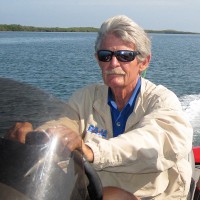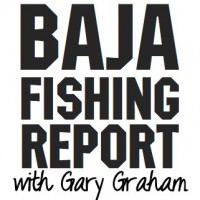
From below the Border at the Bull Ring out to the Coronado Islands, fishing continues offering shots at catching some legal-sized barracuda. First, find the bait/birds and you are on them! Cast out surface iron in various colors – blue/white and black/white are excellent color choices, then allow them to sink a bit and retrieve them at a 45-degree angle.
Calico bass are biting okay. The best bet for them is using anchovy for chum on the kelp line in front of the Bull Ring, but there have been bass on the hard bottom spots too.
Sand bass are coming off sonar schools on the Flats. They are chewing the lead head and squid combo, plastics tipped with squid, along with anchovy and sardines.
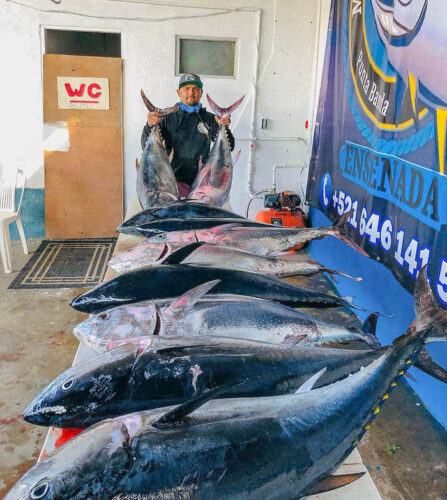
There have been some bluefin tight to the beach from the Rockpile down to Ensenada. These fish seem to be popping up along the color break where the dirty water meets the clean water, running up along the Mexican coastline. Check the chlorophyll charts for the latest on where these breaks are sitting.
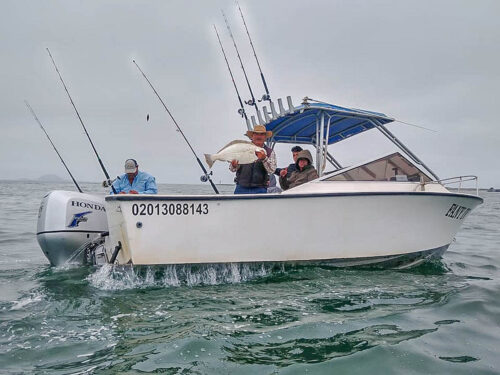
At San Quintín, some bluefin are still found offshore by determined anglers. Others simply enjoy the recent off-the-chart halibut bite while waiting for a break in the weather. Judging by the photo it might be a little rougher farther offshore.
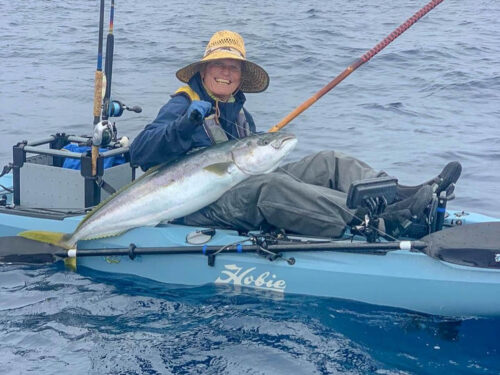
Cedros Island is back in business and the yellowtail, calico bass, white fish, sheepshead, and even bonito and barracuda are on the catch list for July.

At Magdalena Bay, the inshore action in the mangroves has lit up offering an astonishing variety of fish for the few anglers visiting. Mag Bay is one of the best-kept secrets in Baja Sur that not be overlooked!
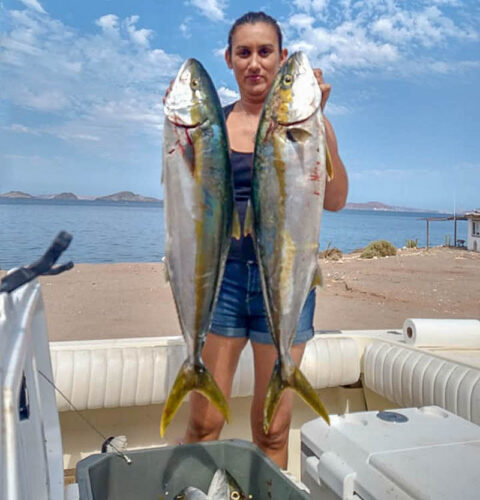
In Bahía de Los Ángeles, the summer heat is sweltering. However, yellowtail, cabrilla, and some huge grouper do not seem to care. If you are looking for excellent, uncrowded fishing, BOLA is ready and waiting.
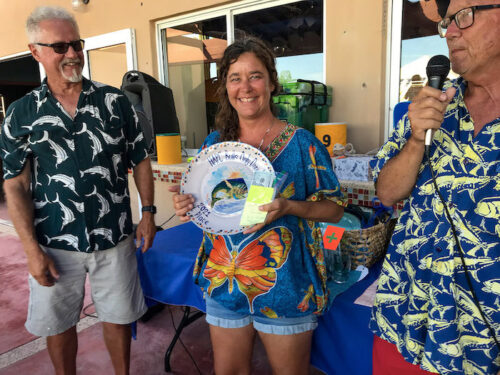
Nineteen teams registered for Punta Chivato’s annual “Bulls Only Tournament” seeking serious dorado action like the old days. Unfortunately, it was slow fishing under rough water conditions. But it was first-timer Dianna Leonard with her 12-pounder who topped the field, the second place belonged to Ethan Fodder with an 11.5-pounder, and third, went to Jamie Gallagher with his 10-pounder.
Mid-June reports reflected a great year for roosterfish as well as good catches of dorado!
The dorado action has been happening north of Punta Lobo along a current line. Lots of peanut-sized dorado are being caught and released with large bulls in the mix.
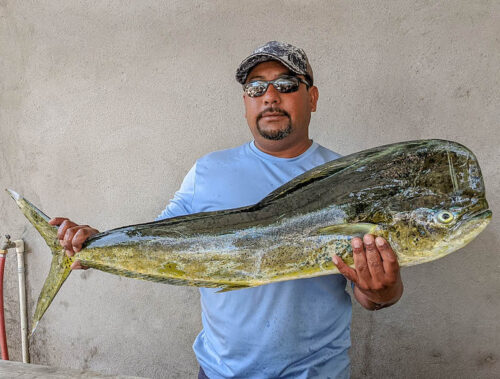
Sardina has been the “name of the game,” however, a fresh live mackerel was the secret sauce for the bigger bulls. No reports on trolling results with tuna feathers or marlin rigs. Most boats headed to the”spot” and looked for birds or sargasso patches.
Yellowtail and baqueta were found at the southern high spots near Danzante and the Six Mile Bank.
The biggest surprise has been the numbers of roosterfish being spotted and caught which seems to be shaping up to be a banner year.
Signs indicate the East Cape area is on the verge of summer. Stripe marlin are not far offshore, yellowfin are traveling with porpoise, and a sprinkling of “keeper” dorado appear to point to exciting days ahead.
Jack crevalle, roosterfish, and even a few pompano have anglers running clickety-split up and down the white sandy beaches.
For the first time in several years, La Paz reports that fishing for billfish has been wide open. The anglers on the pangas were hooking from one to five marlin or sailfish per day!
Even if anglers were not fishing for marlin, at times the fish would swim around the pangas. Folks who weren’t interested in hooking them reported as the boat drove away, the marlin followed.
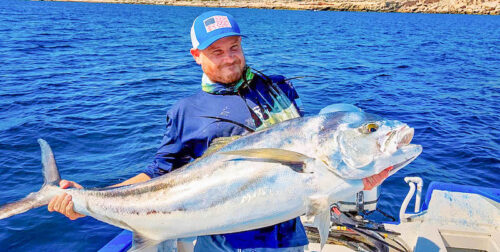
Some roosterfish were as small as 15- to 20-pounds, but in many cases, when larger bait was used, 70-90 pounders bit. Anglers fishing lighter tackle for dorado or other species suddenly found themselves on a long billfish battle, at times lasting over an hour. Several first-timers got the thrill of a lifetime hooking billfish on long struggles. On several occasions, there were double and triple hook-ups on marlin, or an angler would hook a smaller dorado or bonito only to have a huge marlin eat the hooked fish!
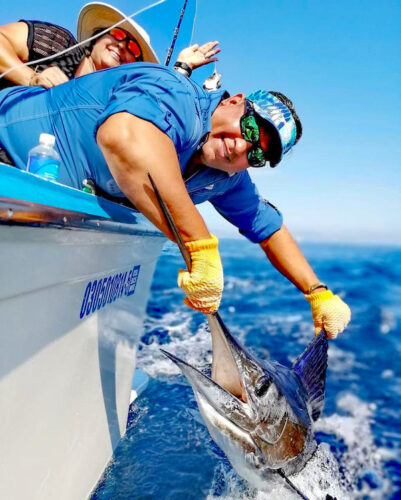
East Cape seems poised for a stellar summer of fishing. The warmer-than-normal water is helping. Limits of yellowfin have been available for a while. The boats are limiting out on tuna by 11 a.m., coming back inside and releasing multiple billfish. The dorado are showing with some big bulls daily, and big roosters are abundant along all the beaches.
At Puerto Los Cabos, there are reports of an early yellowfin bite in the 10- to 40-pound class on the grounds near Vinorama, within a couple of miles from shore. The fish strike on sardina early in the morning, then as the sun rises higher, the action stops, but not before some charters report up to ten tuna. Additional tuna action was found over 25 miles offshore associated with the porpoise, which was more of a private boat deal. This tuna action was the highlight of the weekend.
Some boats ran into schools of baby-sized dorado, all “catch and release.” Billfish action for small-sized, very tiny striped marlin, as small as 40-pounds up to 70-pounds, with a few sailfish in the mix, has been scattered.
Anglers have been catching large numbers of good-eating fish. A great variety of fish was accounted for in the shallow-water structure, triggerfish, pompano, island jack, surgeonfish, red, yellow, and rose snapper, barred pargo, bonito, Amalco jack, leopard grouper, and even more. One very impressive 90-pound Amalco jack was weighed in. Along the shore, there have been more jack crevalle than roosterfish, though more roosterfish are showing up now.
At Cabo San Lucas. huge schools of yellowfin tuna, from football-sized to nearly-200-pound size, were found traveling with pods of porpoise.
There have been a few larger dorado mixed in with the smaller schoolies. Inshore, roosterfish, small dorado, and an ample mix of bottom fish round out the day’s catch.

With more than five decades of fishing experience – from light tackle and fly to offshore billfish – Gary Graham has experienced all aspects of fishing in the Southern California and Baja waters. His observations of species behavior, tackle and techniques are always from his unique perspective, earning him the respect of his peers as well as anglers who eagerly follow his Baja reports and features.
Gary maintained a home at East Cape in Baja Sur for more than 18 years and still spends nearly half of each year exploring the entire peninsula in his self-contained Roadtrek van. He observes everything Baja, from the mysteries of a tide pool on a deserted Baja beach filled with tiny sea creatures to the largest billfish in the sea.

